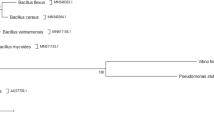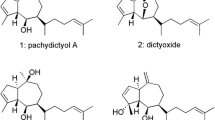Abstract
This paper reports the antifouling properties of the dichloromethane crude extract (DC) and 3 pure compounds isolated from the Brazilian brown seaweed Canistrocarpus cervicornis against establishment of the mussel Perna perna. DC extract showed a strong inhibition activity against byssal threads. Two natural dolastanes and one seco-dolastane diterpene, namely (4R, 9S, 14S)-4α-acetoxy-9β,14α-dihydroxydolast-1(15),7-diene (1), (4R,7R,14S)-4α,7α-diacetoxy-14-hydroxydolast-1(15),8-diene (2) and isolinearol (3), were isolated from DC extract. Dolastane (1) inhibited 60% of byssal fixation, while compound 2 and the seco-dolastane (3) strongly inhibited (82%) the establishment of P. perna. This is the first report of this type of chemical skeleton in three powerful compounds that could be further explored for the development of antifouling technology.




Similar content being viewed by others
References
Barbosa JP, Teixeira VL, Pereira RC (2004) A dolabellane diterpene from the brown alga Dictyota pfaffi as chemical defense against herbivores. Bot Mar 47:147–151 doi:10.1515/BOT.2004.015
Barbosa JP, Fleury BG, da Gama BAP, Teixeira VL, Pereira RC (2007) Natural products as antifoulants in the Brazilian brown alga Dictyota pfaffii (Phaeophyta, Dictyotales). Biochem Syst Ecol 35:549–553 doi:10.1016/j.bse.2007.01.010
Bhadury P, Wright PC (2004) Exploitation of marine algae: biogenic compounds for potential antifouling applications. Planta 219:561–578 doi:10.1007/s00425-004-1307-5
Brock E, Nylund GM, Pavia H (2007) Chemical inhibition of barnacle larval settlement by the brown alga Fucus vesiculosus. Mar Ecol Prog Ser 337:165–174 doi:10.3354/meps337165
Clavico EEG, Muricy G, Da Gama BAP, Batista D, Ventura CRR, Pereira RC (2006) Ecological roles of natural products from the marine sponge Geodia corticostylifera. Mar Biol (Berl) 148:479–488 doi:10.1007/s00227-005-0097-z
Da Gama BAP, Pereira RC, Carvalho MGV, Coutinho R, Yoneshigue-Valentin Y (2002) The effects of seaweed secondary metabolites on biofouling. Biofouling 18:13–20 doi:10.1080/08927010290017680
Da Gama BAP, Pereira RC, Soares AR, Teixeira VL, Yoneshige-Valentin Y (2003) Is the mussel test a good indicator of fouling activity? A comparison between laboratory and field assays. Biofouling 19:161–169 doi:10.1080/0892701031000089534
Davis AR, Moreno CA (1995) Selection of substrata by juvenile Choromytilus chorus (Mytilidae): are chemical cues important? J Exp Mar Biol Ecol 191:167–180 doi:10.1016/0022-0981(95)00049-W
De Clerck O, Leliaert F, Verbruggen H, Lane CE, De Paula JC, Payo DI et al (2006) A revised classification of the Dictyoteae (Dictyotales, Phaeophyceae) based on rbcL and 26S ribosomal DNA sequence data analyses. J Phycol 42:1271–1288 doi:10.1111/j.1529-8817.2006.00279.x
Epifanio RA, Da Gama BAP, Pereira RC (2006) 11beta,12beta-Epoxypukalide as the antifouling agent from the Brazilian endemic sea fan Phyllogorgia dilatata Esper (Octocorallia, Gorgoniidae). Biochem Syst Ecol 34:446–448 doi:10.1016/j.bse.2005.12.003
Glombitza KW, Klapperich L (1985) Antibiotics from algae. XXXIV. Cleavage of the high-molecular-weight methylated phlorotannins fraction from the brown alga Pelvetia canaliculata. Bot Mar 28:139–144
González AG, Martin JD, Norte M, Rivera P, Perales A, Fayos J (1983) Structure and absolute configurations of Dictyota sp. diterpenes. Tetrahedron 39:3355–3357 doi:10.1016/S0040-4020(01)91586-8
Hellio C, De La Broise D, Dufossé L, Le Gal Y, Bourgougnon N (2001) Inhibition of marine bacteria by extracts of macroalgae: potential use for environmentally friendly antifouling paints. Mar Environ Res 52:231–247 doi:10.1016/S0141-1136(01)00092-7
Hellio C, Pascal BJ, Beaupoil C, Le Gal Y, Bourgougnon N (2002) Screening of marine algal extracts for anti-settlement activities against microalgae and macroalgae. Biofouling 18:205–215 doi:10.1080/08927010290010137
Jennings JG, Steinberg PD (1997) Phlorotannins vs. others factors affecting epiphyte abundance on the kelp Ecklonia radiata. Oecologia 109:461–473 doi:10.1007/s004420050106
König GM, Wright AD, de Nys R (1999) Halogenated monoterpenes from Plocamium costatum and their biological activity. J Nat Prod 62:383–385 doi:10.1021/np980408y
Kubanek J, Jensen PR, Keifer PA, Sullards MC, Collins DO, Fenical W (2003) Seaweed resistance to microbial attack: a targeted chemical defense against marine fungi. Proc Natl Acad Sci USA 100:6916–6921 doi:10.1073/pnas.1131855100
Li X, Dobretsov S, Xu Y, Xiang X, Hung OS, Qian PY (2006) Antifouling diketopiperazines produced by a deep-sea bacterium, Streptomyces fungicidicus. Biofouling 22:201–208 doi:10.1080/08927010600780771
Lustigman B, Le LH, Thees N, Masucci J (1992) Production of antibacterial substances by macroalgae of the New York/New Jersey coast. Bull Environ Contam Toxicol 49:743–749 doi:10.1007/BF00200789
McClintock JB, Baker BJ (2001) Marine chemical ecology, 1st edn. CRC, Boca Raton, USA
McLachlan J, Craigie JS (1964) Algal inhibition by yellow ultraviolet absorbing substances from Fucus vesiculosus. Can J Bot 42:287–292
Paul VJ (1992) Ecological roles of marine natural products, 1st edn. Comstock–Cornell University Press, New York
Pereira RC, Cavalcanti DN, Teixeira VL (2000) Effects of secondary metabolites from the tropical Brazilian brown alga Dictyota menstrualis on the amphipod Parhyale hawaiensis. Mar Ecol Prog Ser 205:95–100 doi:10.3354/meps205095
Pereira RC, Carvalho MGV, Gama BAP, Coutinho R (2002a) Field experimental evaluation of secondary metabolites from marine invertebrates as antifoulants. Braz J Biol 62:311–320
Pereira RC, Pinheiro MD, Teixeira VL, da Gama BAP (2002b) Feeding preferences of the endemic gastropod Astraea latispina in relation to chemical defenses of Brazilian tropical seaweeds. Braz J Biol 62:33–40
Pereira RC, da Gama BAP, Teixeira VL, Yoneshige-Valentin Y (2003) Ecological roles of natural products of the Brazilian red seaweed Laurencia obtusa. Braz J Biol 63:665–672 doi:10.1590/S1519-69842003000400013
Phillips DW, Towers GHN (1982) Chemical ecology of red algal bromophenols: temporal, interpopulational and within-thallus measurements of lanosol levels in Rhodomela larix. J Exp Mar Biol Ecol 58:287–293
Qian PY, Dahms HU, Dobretsov S (2006) Inhibition of biofouling by marine microorganisms and their metabolities. Biofouling 22:43–54 doi:10.1080/08927010500504784
Railkin AI (2004) Marine biofouling: colonization processes and defenses, 1st edn. CRC, Boca Raton, FL
Sastry VMVS, Rao GRK (1994) Antibacterial substances from marine algae: successive extraction using benzene, chloroform and methanol. Bot Mar 37:357–360
Schmitt TM, Hay ME, Lindquist N (1995) Constraints on chemically mediated coevolution: multiple functions for seaweed secondary metabolites. Ecology 76:107–123 doi:10.2307/1940635
Sieburth JM, Conover JT (1965) Sargassum tannin, an anti-biotic which retards fouling. Nature 208:52–53 doi:10.1038/208052a0
Sudatti DB, Rodrigues SV, Coutinho R, Da Gama BAP, Salgado LT, Amado Filho GM, Pereira RC (2008) Transport and defensive role of elatol at the surface of the red seaweed Laurencia obtusa (Ceramiales, Rhodophyta). J Phycol 44:584–591
Teixeira VL, Tomassini T, Fleury BG, Kelecom A (1986) Dolastane and seco-dolastane diterpenes from the marine brown alga Dictyota cervicornis. J Nat Prod 49:570–575 doi:10.1021/np50046a002
Yebra DM, Kiil S, Dam-Johansen K (2004) Antifouling technology-past, present and future steps towards efficient and environmentally friendly antifouling coatings. Prog Org Coat 50:75–104 doi:10.1016/j.porgcoat.2003.06.001
Zar JH (1999) Biostatistical analyses, 4th edn. Prentice-Hall, New Jersey
Acknowledgments
E.M.B. thanks the National Brazilian Research Council (CNPq) for providing a PhD fellowship, and R.C.P. and V.L.T. thank CNPq for a research productivity fellowship. We are grateful to Dr. Maria Tereza M. Széchy and MSc Joel Campos De Paula for help in the collection and identification of seaweeds.
Author information
Authors and Affiliations
Corresponding author
Rights and permissions
About this article
Cite this article
Bianco, É.M., Rogers, R., Teixeira, V.L. et al. Antifoulant diterpenes produced by the brown seaweed Canistrocarpus cervicornis . J Appl Phycol 21, 341–346 (2009). https://doi.org/10.1007/s10811-008-9374-9
Received:
Revised:
Accepted:
Published:
Issue Date:
DOI: https://doi.org/10.1007/s10811-008-9374-9




